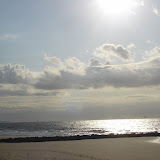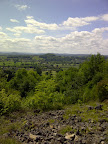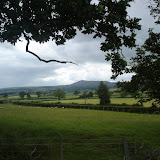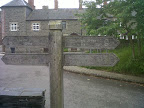After packing up the tent we walked up to the beautiful village of Llandegla. This is where we rejoined the Offa’s Dyke Path, as it passes straight through the village “high street”. It took us past the small Memorial Hall and Post Office (which was the main shop as far as I could tell?) Until we reached the Church. It was really good to see a Sign post to Prestatyn saying that it was only 29 miles away and we had covered 68 miles in the past few days! I do remember the first sign saying it was 97 miles to Prestatyn, so it did feel like we had achieved something!
| From 2011 – 23.06.2011 – Offa’s Dyke Path – Llangdegla and Prestatyn |
It is here that I have to inform that you we had decided to stop our walk. Unfortunately my knee had severely swollen up and the previous evening even the campsite owner had seen me hobbling about the campsite 😦 . I think we were both Disappointed that we were not going to be able to walk the last 29 miles – and tackle the beautiful Clwydian Range – but to be honest in the end I realised, that Offa’s Dyke will be there for us to to return to (and we will!). When I was rested we could carry on walking in Prestatyn – since this was all for Charity!
Whilst waiting for the bus, I took a look around the Saint Tecla Church. I was rather struck by the beautiful stained glass window. In fact this window is actually rare example of a smoked glass and not a stained glass window at all. The window was made about 1800 where it was originally installed in St Asaph Cathedral. During restoration work of the Cathedral it was moved to the Church during the early 19th Century.
 |
| From 2011 – 23.06.2011 – Offa’s Dyke Path – Llangdegla and Prestatyn |
We had to leave this beautiful Church and village behind, by catching a bus to Denbigh. Where we stopped for a while, a lovely Welsh town – disappointingly I do not seem to have any photos to hand? We took the bus here to Rhyl where we a caught a train to Prestatyn, where the official finish of our walk was.
We found a somewhere to camp in Prestatyn for the night. The site is actually a converted Chapel still provided a beautiful place to camp 🙂 . Despite not being able walking to our last destination, we both felt it was fitting to at least complete the rest of the “Dyke” from the Campsite. “Plas Ifan” was situated directly along the path and it was quite interesting to note that they were advertising that 2011 is the path’s 40th anniversary. Prestatyn was ensuring that path was well and truly celebrated with a festival this year!
| From 2011 – 23.06.2011 – Offa’s Dyke Path – Llangdegla and Prestatyn |
The “dyke” was seemingly not as picturesque we had previously encountered as we were now walking along the roads in Prestatyn. However, it seemed quite refreshing to be in a town environment after encountering cows, grumpy sheep, being isolated in the middle of seemingly nowhere and being amongst people for a change 🙂 . The path took us along the high street and across the road railway bridge (*Hopefully after June 2011 the path will have a better route across the railway this was still under construction) and then toward the sea.
We past “Lido Beach”, which I presume is a caravan park, rather than an actual Lido. Particularly as there is not much evidence of the Lido any more, except the shop which looks like it could have been entrance? All I can find out about the Lido, are a very few memories about the outdoor baths that used to be here at Prestatyn. Does anyone has any other thoughts?
The path continues by the Bastion Gardens until we reached the seafront. It was here we finally reached our Journey’s end. It was the official end of our hike. Offa’s Dyke Path was marked by a large stainless steel statue. We were informed by the site owner that the shape of the statue was to capture the sun rising and setting. It was to be the new official end of the path. I had mixed emotions – glad we had made it – sad we had missed a lot – glad we had raised money for charity by doing the walk!
| From 2011 – 23.06.2011 – Offa’s Dyke Path – Llangdegla and Prestatyn |
I was completely swept away by Prestatyn Beach. It is so beautiful. When I said that we had reached the official end of our walk, legend says the Dyke actually went out to sea, and we should have walked out onto the beach! Prestatyn Sands are really quite something to behold. I shall go into this more in another blog!
As we had a little more time we decided to stroll on from our wonderful adventure to look around. We were not disappointed with our next find. Prestatyn Pontins. Not very exciting you may think – but for any film fans out there, this is where “Holiday On the Buses” was filmed! It was odd to see the same looking gates as the film! I think other things may have changed though – all for the good 🙂 As we left Pontins behind we were treated to a fabulous sunset to end our day before drifting back to the tent….
I just want to say a big thank you for anyone who sponsored me on this walk and for everyone’s support!
For all the photos of the day please click here –
 |
| 2011 – 23.06.2011 – Offa’s Dyke Path – Llangdegla and Prestatyn |
<><









